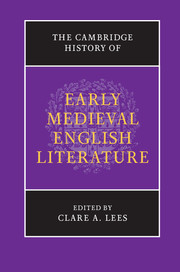Book contents
- Frontmatter
- Contents
- List of Illustrations
- List of Contributors
- Acknowledgements
- List of Abbreviations
- Introduction: literature in Britain and Ireland to 1150
- I WORD, SCRIPT AND IMAGE
- 1 Writing in Britain and Ireland, c. 400 to c. 800
- 2 The art of writing: scripts and scribal production
- 3 Art and writing: voice, image, object
- 4 Of Bede’s ‘five languages and four nations’: the earliest writing from Ireland, Scotland and Wales
- 5 Insular Latin literature to 900
- 6 Bede and the northern kingdoms
- II EARLY ENGLISH LITERATURE
- III LATIN LEARNING AND THE LITERARY VERNACULARS
- Bibliography
- Index of manuscripts
- Index
3 - Art and writing: voice, image, object
from I - WORD, SCRIPT AND IMAGE
Published online by Cambridge University Press: 05 February 2013
- Frontmatter
- Contents
- List of Illustrations
- List of Contributors
- Acknowledgements
- List of Abbreviations
- Introduction: literature in Britain and Ireland to 1150
- I WORD, SCRIPT AND IMAGE
- 1 Writing in Britain and Ireland, c. 400 to c. 800
- 2 The art of writing: scripts and scribal production
- 3 Art and writing: voice, image, object
- 4 Of Bede’s ‘five languages and four nations’: the earliest writing from Ireland, Scotland and Wales
- 5 Insular Latin literature to 900
- 6 Bede and the northern kingdoms
- II EARLY ENGLISH LITERATURE
- III LATIN LEARNING AND THE LITERARY VERNACULARS
- Bibliography
- Index of manuscripts
- Index
Summary
Writing and art were integrated phenomena in Anglo-Saxon England, arguably more so than they were for any other medieval period or culture. The Anglo-Saxons used representation to make manifest both the art of writing and what exactly it meant to write (in Latin, ‘scribere’). The Evangelist portraits in the early eighth-century Lindisfarne Gospels (London, British Library, MS Cotton Nero D. iv) are the earliest images of writing Evangelists to survive from northern Europe, and depictions of books, authors, readers and writers of all sorts grew ever more complex as the centuries progressed. In the c. 1020 Eadwig (or Hannover) Gospels (Hannover, Kestner Museum, MS WM XXIa 36) the four Evangelists form a sequence that documents the art of writing from picking up the pen, to sharpening the pen, to writing, to displaying the words just written. The images in effect document the production of the book, which seems particularly appropriate as the manuscript was written and probably illustrated by the famous Christ Church Canterbury scribe Eadwig Basan. To a certain extent we have come to expect the interaction of text and image in illuminated manuscripts as both words and images are integral to this type of book, but the Anglo-Saxons extended the relationship between script and image to other types of objects, even architecture. And just as they had used art to interrogate what it meant to write, they used objects and monuments to interrogate what it meant to inscribe, to write into something. Writing visualizes voice, and the Anglo-Saxons used inscription to embed voice into objects. Until quite recently this has been an almost unexplored aspect of Anglo-Saxon art. There have been studies of the language of inscriptions, and numerous studies of individual inscribed objects, but very few have focused on the intersection of text, object and voice. This chapter will explore three different relationships between writing and art that are absolutely characteristic of Anglo-Saxon culture: the use of script as image; the dialogue between script and image; and the way in which that dialogue changes when the object is made to speak.
- Type
- Chapter
- Information
- Publisher: Cambridge University PressPrint publication year: 2012
- 2
- Cited by



